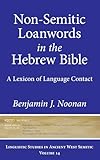Non-semitic loanwords in the Hebrew Bible : a lexicon of language contact / Benjamin J. Noonan.
Material type: TextSeries: Publication details: University Park, Pennsylvania : The Pennsylvania State University Press, (c)2019.Description: xxxv, 512 pages ; 24 cmContent type:
TextSeries: Publication details: University Park, Pennsylvania : The Pennsylvania State University Press, (c)2019.Description: xxxv, 512 pages ; 24 cmContent type: - text
- unmediated
- volume
- 9781575067742
- BS525 .N667 2019
- BS525
- COPYRIGHT NOT covered - Click this link to request copyright permission:
| Item type | Current library | Collection | Call number | Status | Date due | Barcode | |
|---|---|---|---|---|---|---|---|
| Reference (Library Use ONLY) | G. Allen Fleece Library REFERENCE | RES | BS525.N66.N667 2019 (Browse shelf(Opens below)) | Available | 31923001719646 |
Browsing G. Allen Fleece Library shelves, Shelving location: REFERENCE Close shelf browser (Hides shelf browser)

|

|

|

|

|

|

|
||
| BS511.3.B435.C666 2007 Commentary on the New Testament use of the Old Testament /edited by G.K. Beale and D.A. Carson. | BS511.3.R644.O946 2006 The Oxford handbook of biblical studies /edited by J.W. Rogerson and Judith M. Lieu. | BS511.3.T384.I584 2006 Interpreting the Bible : a handbook of terms and methods / | BS525.N66.N667 2019 Non-semitic loanwords in the Hebrew Bible : a lexicon of language contact / | BS537.B855.F548 1993 Figures of speech used in the Bible, explained and illustrated /by E.W. Bullinger. | BS537 .B87 1968 Figures of speech used in the Bible, explained and illustrated /by E.W. Bullinger. | BS537 .H453 2018 How old is the Hebrew Bible? : a linguistic, textual, and historical study / |
CIU Faculty Author.
Introduction: History of research -- Corpus and parameters of this study -- Terminology -- Identifying loanwords -- Mechanisms of borrowing -- Loanwords as cultural symbols -- Conclusion -- Non-semitic contact in ancient Palestine: The Egyptians -- The Greeks -- The Hittites and Luvians -- The Hurrians -- The Indo-Aryans -- The Iranians -- Conclusion -- Non-Semitic loanwords in the Hebrew Bible -- Quantitative analysis: Methodology and terminology -- General distribution of the Hebrew Bible's loanwords -- Loanwords and the Hebrew Bible's canonical divisions -- Loanwords and the Hebrew Bible's source-critical divisions -- Loanwords and parts of speech -- Loanwords and domain of use -- Linguistic analysis: Phonology -- Orthography -- Morphology -- Evidence for dialect of origin and date of borrowing: Egyptian -- Greek -- Hittite and Luvian -- Hurrian -- Old Indic -- Old Iranian -- Synthesis -- Non-Semitic loanwords as evidence for foreign contact in ancient Palestine: The Egyptians -- The Greeks -- The Hittites and Luvians -- The Hurrians -- The Indo-Aryans -- The Iranians.
Ancient Palestine served as a land bridge between the continents of Asia, Africa, and Europe, and as a result, the ancient Israelites frequently interacted with speakers of non-Semitic languages, including Egyptian, Greek, Hittite and Luwian, Hurrian, Old Indic, and Old Iranian. This linguistic contact led the ancient Israelites to adopt non-Semitic words, many of which appear in the Hebrew Bible. Benjamin J. Noonan explores this process in Non-Semitic Loanwords in the Hebrew Bible, which presents a comprehensive, up-to-date, and linguistically informed analysis of the Hebrew Bible's non-Semitic terminology. In this volume, Noonan identifies all the Hebrew Bible's foreign loanwords and presents them in the form of an annotated lexicon. An appendix to the book analyzes words commonly proposed to be non-Semitic that are, in fact, Semitic, along with the reason for considering them as such. Noonan's study enriches our understanding of the lexical semantics of the Hebrew Bible's non-Semitic terminology, which leads to better translation and exegesis of the biblical text. It also enhances our linguistic understanding of the ancient world, in that the linguistic features it discusses provide significant insight into the phonology, orthography, and morphology of the languages of the ancient Near East. Finally, by tying together linguistic evidence with textual and archaeological data, this work extends our picture of ancient Israel's interactions with non-Semitic peoples. A valuable resource for biblical scholars, historians, archaeologists, and others interested in linguistic and cultural contact between the ancient Israelites and non-Semitic peoples, this book provides significant insight into foreign contact in ancient Israel.
COPYRIGHT NOT covered - Click this link to request copyright permission:
There are no comments on this title.
